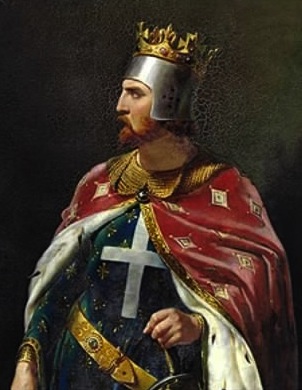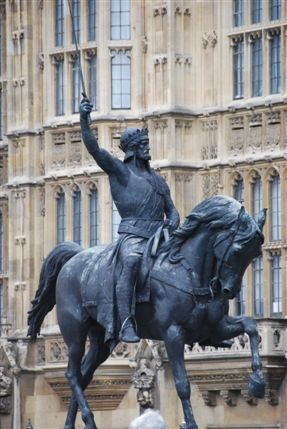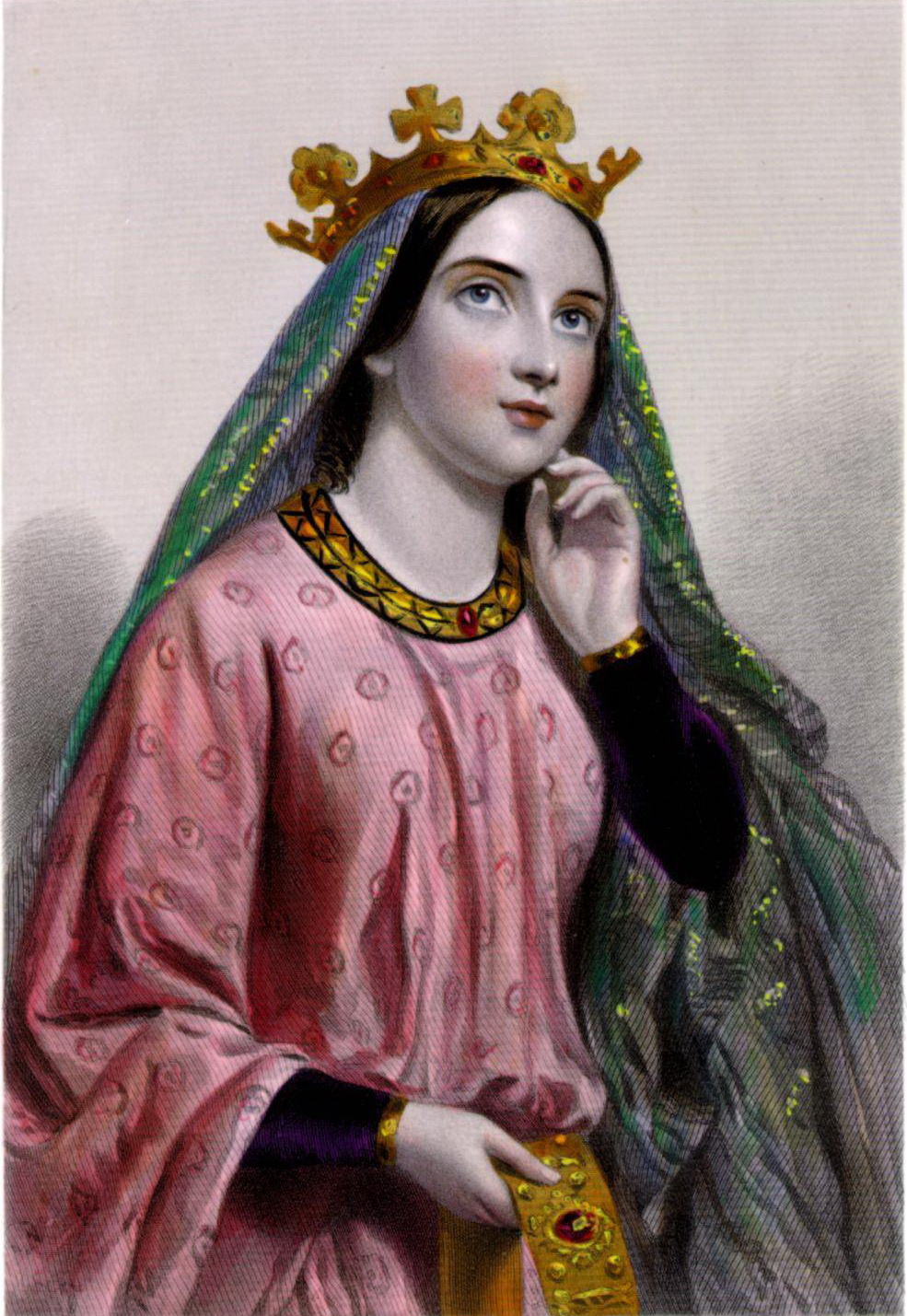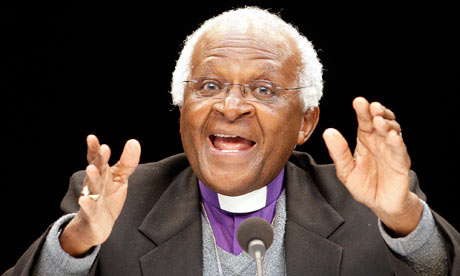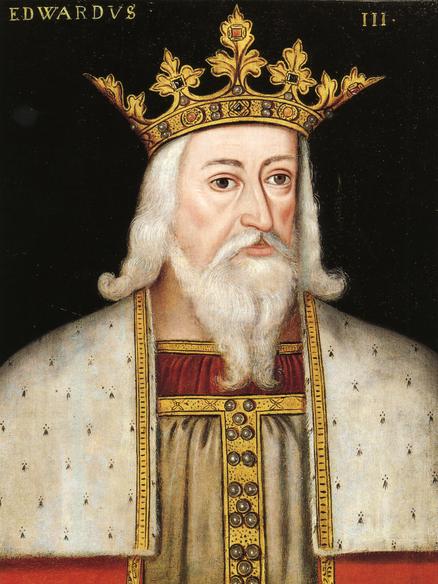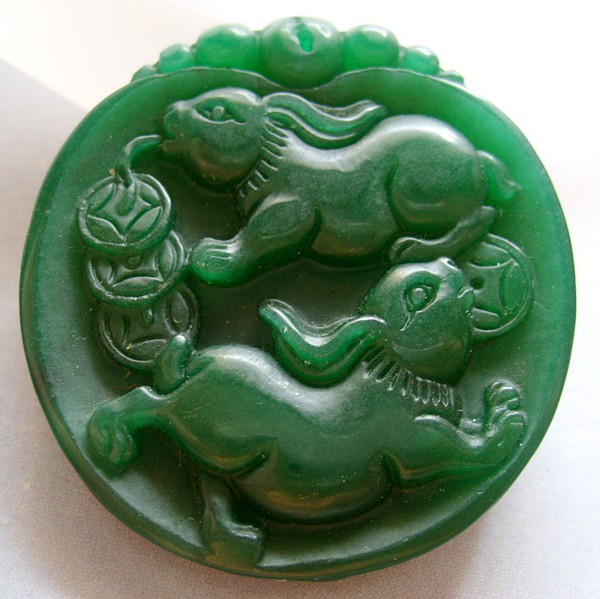Name: King Richard I The Lion Heart
Born: September 6, 1157 at Beaumont Place, Oxford
Parents: Henry II and Eleanor of Aquitaine
Relation to Elizabeth II: 21st great-granduncle
House of: Angevin
Ascended to the throne: July 6, 1189 aged 31 years
Crowned: 2/3 September, 1189 at Westminster Abbey
Married: Berengaria, Daughter of Sancho V of Navarre
Children: Two illegitimate sons
Died: April 6, 1199 at Limousin, France, aged 41 years, 6 months, and 29 days
Buried at: Fontevraud, France
Reigned for: 9 years, 8 months, and 30 days
Succeeded by: his brother John
Richard I (8 September 1157 – 6 April 1199) was King of England from 6 July 1189 until his death. He also ruled as Duke of Normandy (as Richard IV), Duke of Aquitaine, Duke of Gascony, Lord of Cyprus, Count of Anjou, Count of Maine, Count of Nantes, and Overlord of Brittany at various times during the same period. He was known as Richard Cœur de Lion, or Richard the Lionheart, even before his accession, because of his reputation as a great military leader and warrior. The Saracens called him Melek-Ric or Malek al-Inkitar – King of England.
By the age of sixteen, Richard had taken command of his own army, putting down rebellions in Poitou against his father, King Henry II. Richard was a central Christian commander during the Third Crusade, leading the campaign after the departure of Philip II of France and scoring considerable victories against his Muslim counterpart, Saladin, although he did not reconquer Jerusalem.
Richard spoke the langue d’oïl and the langue d’oc and spent very little time in England (he lived in his Duchy of Aquitaine in the southwest of France, preferring to use his kingdom as a source of revenue to support his armies). He was seen as a pious hero by his subjects. He remains one of the few kings of England remembered by his epithet, rather than regnal number, and is an enduring iconic figure in England and France.
Richard was the third son of Henry II. He twice rebelled against his father before he became King of England in 1189, but based himself in his Duchy in Aquitaine inherited from his mother Eleanor. He spent only six months of his reign in England and spoke only French. He appointed William Longchamp as Chancellor of England during his absence but he was overthrown by Richard’s brother John.
Richard acquired a reputation as a leader and warrior becoming known as Richard ‘The Lion Heart’ or ‘Coeur de Lion’. His experience in warfare came from controlling rebellions in Poitou in the 1170s and against his father, Henry II, in 1183. He took up Henry’s plans to recover Jerusalem on his accession in 1189 and set out to establish bases for crusades in Sicily in 1190 and Cyprus, which he took in 1191. Engaging in the siege of Acre, which he brought to a swift conclusion, he set off down the coast to Jaffa, conducting a fighting march against Saladin.
In the third Crusade 1191–92 he won victories at Cyprus, Acre, and Arsuf (against Saladin), but failed to recover Jerusalem. While returning overland he was captured by the Duke of Austria, who handed him over to the emperor Henry VI. He was held prisoner until a large ransom was raised.
On his release he returned briefly to England, where his brother John had been ruling in his stead. His later years were spent in warfare in France, where he was killed by a crossbow bolt while besieging Châlus-Chabrol in 1199. He left no heir.
| Timeline for King Richard I The Lion Heart |
| 1189 | Richard I becomes King of England upon the death of Henry II |
| 1189 | William Longchamp is appointed Chancellor of England and governs the country during Richard’s absence abroad |
| 1189 | Richard sets out with Philip of France on the Third Crusade to the Holy Land |
| 1191 | William Longchamp falls from power and Richard’s brother, John, takes over the government |
| 1191 | Richard captures the city of Acre, Palestine, and defeats Saladin at Arsuuf, near Jaffa |
| 1192 | Richard reaches an agreement with Saladin to guarantee Christians safe pilgrimage to Jerusalem |
| 1192 | On his way back to England from Palestine, Richard is captured and handed over to Henry VI, Emperor of Germany. Henry demands a ransom of 100,000 marks from England for Richard’s release from prison |
| 1194 | The ransom is raised in England. Richard is released from captivity. |
| 1195 | Richard returns to England for a brief period, before leaving to fight in France, never to return to his homeland. |
| 1196 | The Assize of Measures standardizes weights including the lb (pound) and distance including the yard. |
| 1199 | Richard is mortally wounded by an arrow from a crossbow in battle at Chalus, in France. |
Richard I the Lionheart
1189-99
Despite his faults, which were many, Richard I was the archetypal medieval warrior king. Noble, fierce and of matchless courage, he captured the imagination of his age. Richard ‘the Lionheart’ has left behind a name which echoes down the centuries and has passed into the realms of legend.
Parentage and Early Life
Richard was born at Beaumont Palace, Oxford, on 8th September, 1157, the third son of Henry II and his French wife, Eleanor of Aquitaine, the daughter of William X, Duke of Aquitaine and ex wife of King Louis VII of France. Henry was Eleanor’s second husband, she was eleven years his senior and their marriage proved to be a stormy one.
From the first, Richard was his mother’s favourite son. His wet nurse, Hodierna, was the mother of Alexander Neckham, who was to become Abbot of Cirencester and a famous writer. After the birth of their youngest child, John, Richard’s parents drifted into open enmity. King Henry made the beautiful Rosamund Clifford his mistress, it was said that he truly loved her, deeply wounding Richard’s mother, Queen Eleanor. The neglected Queen returned to her native Aquitaine, there establishing her own court and taking Richard along with her, who was designated her heir.
Richard was known to be fond of music and was nurtured in the troubadour culture of his mother’s southern homeland. From the outset, he exhibited the volatile disposition and energy inherent in the Plantagenet family. He was said to be fond of quoting the Angevin family legend “From the Devil we sprang and to the Devil we shall go.”
In 1172, when he was fourteen years old, Richard was invested with his mother’s inheritance of Aquitaine and Poitou at Limoges. He joined his discontented elder brother Henry in rebellion against their father, when Eleanor of Aquitaine attempted to join them in Paris, travelling dressed as a man, she was captured by one of her husband’s patrols and was imprisoned for the remainder of Henry II’s reign. The untimely death of Henry, the Young King later made Richard heir to the entire Angevin Empire. In 1187, caught up in the crusading spirit which spread through Christendom, Richard made a solemn vow to free the Holy City, Jerusalem, from the clutches of the Moslem leader Saladin, by whom it had been captured.
Richard’s appearance and character
Richard Plantagenet grew to be a tall man of around six feet four inches, a graceful figure with long legs and an athletic build, in later years he had a tendency to grow stouter. He had an abiding appreciation of poetry and music and a love of fine clothing, probably inherited from his mother, Queen Eleanor. His hair was red, like his father’s, his eyes grey and furious, he had also inherited his full quota of the infamous Plantagenet temper, causing him to be ever at odds with his equally fiery tempered father.
Reign
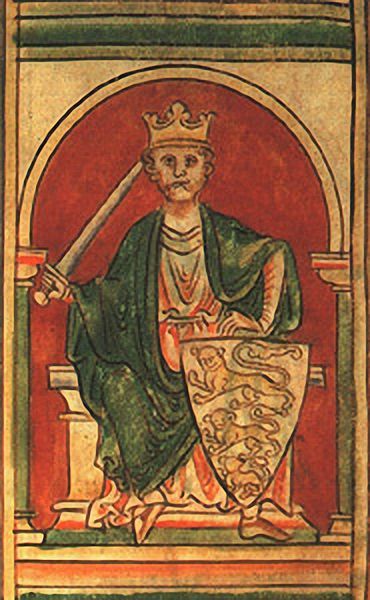 Richard was in open rebellion against Henry II when the latter died in 1189 but on succeeding to the throne he acted generously to William Marshall and to all who had remained loyal to his father and honoured his last wishes. One of his first actions as king was to order the release of his much loved mother, Queen Eleanor, from the captivity she had endured for the last ten years.
Richard was in open rebellion against Henry II when the latter died in 1189 but on succeeding to the throne he acted generously to William Marshall and to all who had remained loyal to his father and honoured his last wishes. One of his first actions as king was to order the release of his much loved mother, Queen Eleanor, from the captivity she had endured for the last ten years.
His coronation took place in Westminster Abbey on the 23rd of September 1189. During the ceremony, a bat was seen to zig-zag around the King’s head in its erratic flight. Many in those suspicious days saw this as an evil omen.
Richard honoured another of his father’s dying wishes in having his illegitimate half-brother Geoffrey, nominated as Archbishop of York. Geoffrey was a man of talent and ambition, but was possessed of a genius for tactlessness, he had a fiery temper and was incapable of compromise. He became embroiled in disputes with the canons of York and others of the clergy. The only spiritual function of his office that the new Archbishop seemed to apply himself to with vigour was that of excommunicating those whom he quarreled with, and they were many.
When the Pope summoned Geoffrey to Rome, he characteristically refused to comply and was accordingly suspended from his office. Geoffrey turned to Richard for help, asking him to intercede with the Pope, the new King listened sympathetically to his half-brothers complaints until Geoffrey went on to rebuke the King for the immoral life he had lead, warning him he ought to mend his ways. Richard, exasperated, could stand no more, he flew into a violent rage, confiscated his estates and ordered him from his presence.
The Third Crusade
Richard’s attention was captivated by the Crusade he had promised to lead. England seems to have been regarded as little more than a source of revenue. He is reported to have said “I would sell London itself if only I could find a rich enough buyer.” Richard made out a will leaving his nephew, Arthur of Brittany as heir to the entire Angevin Empire. All preparations being carried out by July 1190, the English and their French allies led by Phillip Augustus set out on their momentous enterprise.
The Crusaders stopped en-route at Sicily, where Richard’s sister, Joanna, the dowager Queen, was being held captive by her nephew, Tancred, the new King, who was also refusing to return her dowry. Tancred became more amenable when Richard arrived on the scene and when he captured the city of Messina, Tancred was forced to release her. Phillip, outshone by Richard, sulked. He raised the issue of his sister, Alys, who had been betrothed to Richard since childhood. Gossip claimed that Richard refused to marry Alys as she had been seduced by his father and was even rumoured to have borne the late King’s child.
The English King informed Phillip that he intended to marry the Princess Berengaria of Navarre, the daughter of Sancho VI of Navarre, whom his mother was escorting to Sicily. Richard and Berengaria had met only once prior to their espousal, at a tournament at Pamplona held by her father. There was little the slighted Phillip could do other than simmer.
The voyage to the Holy Land continued, but the ship carrying Berengaria and Joanna was shipwrecked on the coast of Cyprus in the course of a violent storm. The Cyprians besieged the English survivors of the wreck at Limasoll. A large ammount of treasure, intended for use on the crusade, was appropriated by Isaac Comnenus, the Emperor of Cyprus. Richard dispatched a letter to Isaac, which was arrogantly ignored. Outraged, he unleashed the full force of the famed Plantagenet fury on the unfortunate Isaac. The Cyprian Emperor was overthrown and English governors were set up over the island which was used as a garrison for the crusade.
The English contingent of the Third Crusade arrived at Acre, in the Holy Land, at Whitsun, 1191. Richard’s reputation seems to have arrived before him and on 11th of July, the Moslem defenders surrendered the city to the Christian army. Richard, Philip, and Leopold V of Austria, leader of the German contingent to the Crusade, disagreed over the distribution of the spoils of their victory. Richard deeply insulted Leopold when he threw down his standard from the walls of Acre, an action which was to have dire consequences for him in the future. A further cause of dissension among the leaders of the crusade was Richard’s support of Guy de Lusignan, King of Jerusalem, while Philip Augustus and Leopold supported his rival for the title, Conrad of Montferrat.
King Phillip Augustus of France was anxious to return home, he did not enjoy being eclipsed by Richard and was piqued at the repudiation of his sister. He set sail for France on 3rd of August , abandoning the Crusade. An exchange of prisoners from Acre was arranged with Saladin, but problems arose in the arrangements. Richard believed Saladin to be creating delays. He consequently ordered the massacre of all the Moslem prisoners. This act of cruelty remains a bloody stain on his reputation.
On 7th September, at Arsuf, the armies of Richard and Saladin clashed in battle. Saladin was forced to retreat. Richard then marched on Jaffa, and began to strengthen it as a garrison for Jerusalem. The army arrived at the foothills of the Holy City on 3rd January, 1192. They were, however, exhausted , short of supplies and sickness was rife in their ranks, and were consequently obliged to return to the safety of the coast.
A truce was negotiated with the Moslems. A superlative general but a poor politician, Richard proposed that Saladin should give the Holy Land to his nephew Saphadin, whom he suggested should marry his sister Joanna, forming a peaceful alliance between Christian and Moslem. The bemused Saladin, unable to believe his luck, accepted. Joanna, however, who possessed the famed family temper in full measure, refused outright to contemplate marriage with a Moslem, resulting in a heated family dispute.
Richard made attempts to negotiate with Conrad of Montferrat, but Conrad, who distrusted him due to his support of Guy de Lusignan, refused. Following an election of the nobles of the kingdom in April, Conrad was unanimously voted as King of Jerusalem, however, before his coronation could take place, he was murdered at Tyre by two Hashshashin. Conrad held his claim to the throne through his marriage to the heiress Isabella of Jerusalem, who just over a week later was married to Henry II of Champagne, the nephew of both Richard and Phillip, (through Eleanor of Aquitaine’s first marriage to Louis of France). Rumours circulated that Richard had had some involvement in Conrad’s murder.
Richard recieved disquieting news from England, his younger brother John was plotting against him. He made a further approach to Jerusalem but again realised he could not take the city and that he must now urgently return home. Heartened, Saladin then re-took Jaffa. Richard staged a daring counter attack and although heavily outnumbered, put the Moslems to flight. Having negotiated a three year truce, which retained his conquests and gave Christians access to Jerusalem, the King sailed for England.
On the return journey he was shipwrecked and taken prisoner by Duke Leopold of Austria, whom Richard had insulted gravely in the early stages of the crusade. He incarcerated Richard in his castle of Durrenstein and England was forced to pay a hefty ransom of a hundred and fifty thousand marks to free him. Phillip and John in the meantime, had attacked Normandy. On the release of his brother, John quickly deserted Phillip. The King of France, no match for Richard, was soon in retreat.
The Last Years of Richard’s Life
The last phase in Richard’s life was spent in strengthening the Angevin Empire from the machinations of Phillip Augustus. He built the famed Chateau Gaillard, his “saucy castle ” to guard his dominions, on a strategic position, high on a rock at Les Andelys. Richard chose the position of his fortress carefully, it is built on a site where the River Seine curves sharply, in the curve in front of the peninsula on which the castle stands, a hundred metre high cliff juts out over the river. The construction of the castle took little over a year. Phillip boasted he would take it, ” if its walls were made of steel”, Richard retorted he would hold it from Phillip “even if its walls were made of butter”.
Philip Augustus had long cast covetous eyes on the French Angevin Empire and nourished ambitions of regaining these lands for the crown of France, the contested lands of the Vexin and Berry became a bone of contention between the two kings. Richard formed an alliance against Phillip with his father-in-law, Sancho VI of Navarre, who conducted raids on the French king’s lands from the south.
Richard gained several victories over the French. At Freteval in 1194 and at the Battle of Gisors in 1198, when he adopted the motto “Dieu et mon Droit” “God and my Right” which is still used by British monarchs today.
The King spent very little time with his neglected wife, Berengaria of Navarre and there was no issue of the marriage. In fact there is reason to believe that Richard was bi-sexual. Rumours abounded regarding his homo-sexuality in his own lifetime and he once did penance for the sin of sodomy. Richard did have at least one illegitimate son, known as Phillip of Cognac, who steps into the pages of history in Shakespeare’s King John.
In the spring of 1199, a horde of Roman treasure was discovered by a peasant ploughing a field by Chalus, near Limoges, which was delivered to his lord, Archard of Chalus. Richard, as overlord, claimed the find as his and when it was not forthcoming besieged Chalus with his mercenary captain, Mercadier. On the evening of 26th of March while Richard was walking around the castle directing the siege, an archer, using a frying pan as a shield, fired a crossbow bolt at him from the battlements, he ducked too late and the bolt embedded itself in his left shoulder. In attempting to pull the bolt out, the shaft broke, leaving the iron head in his flesh. A clumsy surgeon working by torch light, although succeeding in removing the arrow head, made the wound far worse and gangrene set in.
When the Castle fell, the archer was brought before Richard, who, aware that he was soon to meet his maker, forgave him, stating “Live on, and by my bounty behold the light of day,” he gave orders that he was to be set free and given a hundred shillings. Richard’s devoted mother, Eleanor of Aquitaine, rushed to his side and was with him to the end, he died in her arms on 6th April, 1199. His wife, Berengaria, was not even summoned. Mercadier had the archer sent to Richard’s youngest sister, Joanna, who had him flayed alive and torn apart by wild horses.
Richard was interred at Fontevraud, the grieving Eleanor accompanied her son’s body there, burying him, as he had requested, at the feet of his father. The sooner to ask his forgiveness in another world. His heart was buried at Rouen in Normandy, his entrails he bequeathed to Poitou.
Berengaria of Navarre
After Richard’s death, his widow Berengaria experienced great difficulties in acquiring the pension owed to her as Queen Dowager from Richard’s successor, John. Eleanor of Aquitaine attempted to mediate and the Pope intervened, threatening to place England under an interdict. Berengaria settled at Le Mans, she never remarried, eventually entering the convent of L’Epau Abbey. She died at L’Epau on 23rd December, 1230.
Philip of Cognac
Richard left an illegitimate son, Philip of Cognac, born in the early 1180’s to an unknown mother. Richard had married him to his ward, Amelia, daughter of Itier V, Seigneur of Cognac and heiress of Cognac in Charente, but she died without issue. Philip is reported to have killed Ademar V, Viscount of Limoges, in 1199 in revenge for his father’s death. The chronicler Roger of Howden claimed that later that same year, “Philip, illegitimate son of King Richard of England, to whom the aforesaid king his father had granted the castle and honour of Cognac, slew the previously mentioned Viscount of Limoges in vengeance for his father. Philip’s name comes up once more in the Pipe Rolls for 1201 of his uncle, King John“And to Philip, son of King Richard, one mark as a gift”. A transaction dated 1201 relates that Philip sold his Lordship of Cognac to King John and then disappeared from the records forever.
The Heart of Richard I
On 2nd March, 2013, French scientists revealed the results of a nine month long study on the mummified heart of Richard I, which was rediscovered on 31st July, 1838, by the local historian Achille Deville. The heart was found in a small lead box, complete with his engraved name, close to the memorial to Richard, beneath the choir in Rouen Cathedral, during an excavation. The embalmed heart was separated from Richard’s body at his death.
Although the heart’s condition was too poor to reveal the cause of death, it is now reduced to a quantity of grey-brown coloured powder, the study did rule out the possibility that the crossbow bolt that caused Richard’s death was poisoned, an allegation a medieval chronicler had made at the time. Dr Philippe Charlier, a forensic scientist from Raymond Poincare University Hospital, explained “Our toxicological analysis showed no presence of any arsenic or any other metals, so we haven’t found any proof of any contamination during the end of Richard the Lionheart’s life,” he explained.” Pollen grains found in the sample included poplar and bellflower, confirming that he died in April.
The heart was wrapped in linen, spices and vegetables used in the embalming process were directly inspired by the ones used for the embalming of Christ. Traces of Frankincense, myrtle, daisy, mint and possibly lime were detected, beleived to have been used to give the heart an odour of sanctity.
The Ancestry of Richard I
| Henry III | Father: King Henry II of England | Paternal Grandfather: Geoffrey Plantagenet, Count of Anjou | Paternal Great-grandfather: Fulk of Jerusalem |
| Paternal Great-grandmother: Ermengarde of Maine | |||
| Paternal Grandmother: Empress Matilda | Paternal Great-grandfather: Henry I of England | ||
| Paternal Great-grandmother: Edith of Scotland | |||
| Mother: Eleanor of Aquitaine | Maternal Grandfather: William X, Duke of Aquitaine | Maternal Great-grandfather: William IX, Duke of Aquitaine | |
| Maternal Great-grandmother: Philippa of Toulouse | |||
| Maternal Grandmother: Aenor de Châtellerault | Maternal Great-grandfather: Aimery I, Viscount of Châtellerault | ||
| Maternal Great-grandmother: Dangereuse de L’ Isle Bouchard |
Credits:
Wikipedia
http://www.englishmonarchs.co.uk/
http://www.britroyals.com/

